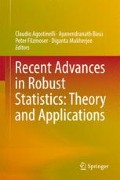Abstract
To design highly robust and efficient tests, a new method based on the so-called variational optimization approach for robust estimation proposed by Shurygin (1994a, b) is developed. A new indicator of robustness of tests, the test stability, is introduced. The optimal decision rules maximizing test efficiency under the guaranteed level of test stability are written out. The proposed stable tests are based on redescending M-estimators as the corresponding test statistics. For hypothesis testing of location, one of those tests, namely a radical test, outperforms the conventional robust linear bounded Huber’s and redescending Hampel’s tests under heavy-tailed distributions although being slightly inferior to Huber’s test under the Gaussian and moderately contaminated Gaussian distributions.
Access this chapter
Tax calculation will be finalised at checkout
Purchases are for personal use only
References
Andrews DF, Bickel PJ, Hampel FR, Huber PJ, Rogers WH, Tukey JW (1972) Robust estimates of location. Princeton Univ. Press, Princeton
Bentkus V, Bloznelis M, Götze F (1995) A Berry-Esseen bound for \(M\)-estimators. Preprint 95-068, Universität Bielifeld
Bohner M Guseinov GSH (2003) Improper integrals on time scales. Dyn Syst Appl 12:45–65
Hampel FR (1974) The influence curve and its role in robust estimation. J Am Stat Assoc 69:383–393
Hampel FR, Ronchetti E, Rousseeuw PJ, Stahel WA (1986) Robust statistics. The approach based on influence functions. Wiley, New York
Hossjer O, Mettiji M (1993) Robust multiple classification of known signals in additive noise - an asymptotic weak signal approach. IEEE Trans Inf Theory 39:594–608
Huber PJ (1964) Robust estimation of a location parameter. Ann Math Statist 35:1–72
Huber PJ (1981) Robust Stat. Wiley, New York
Kim K, Shevlyakov GL (2008) Why Gaussianity? IEEE Signal Process Mag 25:102–113
Michel R, Pfanzagle J (1971) The accuracy of the normal approximation for minimum contrast estimates. Z. Wahrsch Verw Geb 18:73–84
Noether GE (1967) Elements of nonparametric statistics. Wiley, New York
Rousseeuw PJ (1981) A new infinitesemal approach to robust estimation. Z Wahrsch Verw Geb 56:127–132
Rousseeuw PJ, Croux C (1993) Alternatives to the median absolute deviation. J Amer Statist Assoc 88:1273–1283
Shevlyakov GL, Vilchevski NO (2002) Robustness in data analysis: criteria and methods. VSP, Utrecht
Shevlyakov GL, Morgenthaler S, Shurygin A (2008) Redescending \(M\)-estimators. J Stat Plann Infer 138:2906–2917
Shevlyakov GL, Lee JW, Lee KM, Shin VI, Kim K (2010) Robust detection of a weak signal with redescending \(M\)-estimators: a comparative study. Int J Adapt Control Signal Proc 24:33–40
Shevlyakov GL, Shin VI, Lee S, Kim K (2014) Asymptotically stable detection of a weak signal. Int J Adapt Control Signal Proc 28:848–858
Shurygin AM (1994a) New approach to optimization of stable estimation. In: Proceedings 1st US/Japan Conference on Frontiers of Statist. Modeling, Kluwer, Netherlands, pp 315–340
Shurygin AM (1994b) Variational optimization of the estimator stability. Autom Remote Control 55:1611–1622
Shurygin AM (2009) Mathematical methods of forecasting. Text-book, Hot-line-Telecom, Moscow (in Russian)
Tukey JW (1977) Exploratory data analysis. Addison-Wesley, Reading
Acknowledgments
I would like to thank the referees for their important and helpful comments. Also I am so much grateful to Prof. Ayanendranath Basu for his patience and help, which allowed me to finalize this paper.
Author information
Authors and Affiliations
Corresponding author
Editor information
Editors and Affiliations
Rights and permissions
Copyright information
© 2016 Springer India
About this paper
Cite this paper
Shevlyakov, G. (2016). Asymptotically Stable Tests with Application to Robust Detection. In: Agostinelli, C., Basu, A., Filzmoser, P., Mukherjee, D. (eds) Recent Advances in Robust Statistics: Theory and Applications. Springer, New Delhi. https://doi.org/10.1007/978-81-322-3643-6_10
Download citation
DOI: https://doi.org/10.1007/978-81-322-3643-6_10
Published:
Publisher Name: Springer, New Delhi
Print ISBN: 978-81-322-3641-2
Online ISBN: 978-81-322-3643-6
eBook Packages: Mathematics and StatisticsMathematics and Statistics (R0)

